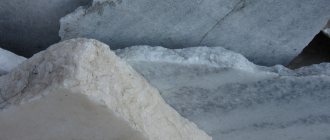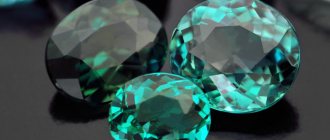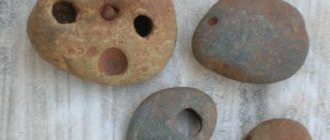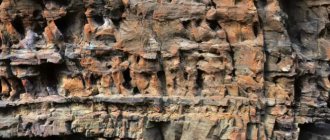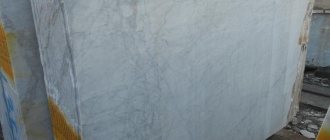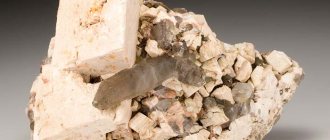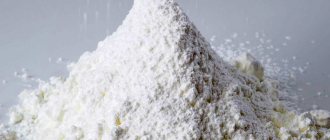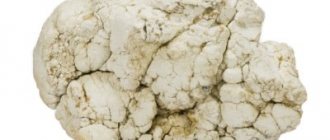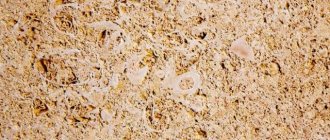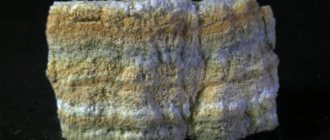Material rating
16 out of 5 Price
20 out of 5
Practicality
20 out of 5
Appearance
20 out of 5
Ease of manufacture
20 out of 5
Environmental friendliness
final grade
4.8
4.8 out of 5
Marble is a rock type of stone that has a crystalline structure. It is mined in developed quarries or in deep mines. Nowadays artificial marble has become popular, which looks like natural stone and even exceeds it in its characteristics.
Technical side of comparison
The marble contains carbonate conglomerates and breccias, and dolomites of high density. It also contains organic matter in its structure.
Technical properties of natural marble:
- Density - 2600-2900 kg/m3
- Water absorption – 0.15 – 0.5%
- Compression resistance – 500-2500 kgf/cm2
- Porosity - 0.6-3.5%
- Abrasion – from 0.40 to 3.20 g/sq.cm
The following indicators are typical for cast marble:
- Density is 18000-2200 kg/m3
- Water absorption – 0.15 – 0.7%
- Abrasion – 0.45
How marble is formed in nature and its history
The age of many deposits is attributed to the Archean, Proterozoic, and Mesozoic eras. Marble was formed due to the recrystallization of dolomite or limestone sedimentary rock. They became compacted and dehydrated under the soil when exposed to climate. The composition contains impurities characteristic of deposits of certain territories and countries.
Marble rock was used in all ancient civilizations. Archaeologists often find items from antiquity. Most often these are sculptures of gods, jewelry, and dishes.
Many marble buildings, including the Taj Mahal and St. Petersburg palaces, survived into the 21st century. The Roman municipality is decorated with sculptures symbolizing the Nile and Tiber rivers. Their durability is unlimited.
Difference in colors
The color depends on the impurities it contains. Most of the stones are variegated. Due to its high cost, artificial stone is gradually beginning to replace natural marble. It is highly decorative and has a huge variety of appearance.
Including:
Structure
There are several varieties of marble. Fine-grained marble, due to its fine-crystalline structure with toothed grain adhesion, has excellent polishing properties. There is coarse-grained marble, in which the cleavage of the grains is clearly visible.
Artificial marble has a homogeneous composition, it is thinner, more durable, and easy to process.
Texture
Marble is the only natural stone that has a huge variety of colors and subtle shades. Its texture is unique and often differs even within the same slab. It can be layered and massive. On polished sections of marble you can see a unique pattern with various combinations of colors. Its color depends on the admixture of metals present in the sedimentary rock.
Conventionally, marble is divided into two groups:
- white;
- color.
Colored marble has many veins.
Artificial marble is similar in texture to natural marble.
Photo of natural stone - red marble
Types of stone
Marble stone differs not only in color, but also in the place of its extraction. The most popular and beautiful varieties of stone are:
- Carrara. A unique milky-white mineral, in some cases tinged with a delicate blue tint, is mined near Carrara in the depths of the Apuan Alps. This type is considered the most valuable; works of art known throughout the world have been created from it, for the production of which blue marble was also used. It is enough to recall at least the famous sculptures of Michelangelo, an outstanding master of the Renaissance.
- Sayan. The stone has white, cream and pink shades. Sayan marble is mined in the mountain range of the same name, located in Russia. A fairly hard material that can be easily processed serves as the basis for the production of small-sized products.
- Jurassic. The dense limestone contains a large number of biological fossils, including algae, sponges and corals. These components give the stone pattern uniqueness and living beauty. The rock is mined in only one place - in the Altmühltal nature park, located in Germany. The rock, which cannot be called marble due to its lack of the distinctive properties of stone, received its name in the Middle Ages.
- Ufaleysky. The stone has gray tones with a blue tint, but it has white veins that form a striped pattern. It is used for the manufacture of decorative elements of architectural objects and acts as an excellent facing material. It got its name due to the fact that it is mined in the Eastern Urals in the Ufaleyskoye deposit.
Types of marble vary depending on where it is found. Most of them are variegated in color.
Environmental friendliness
Since natural marble is created by nature itself, it is very environmentally friendly, and artificial stone is not inferior to it in terms of environmental friendliness, since it is made from materials of natural origin. porosity
This natural material has high porosity, it literally breathes. Therefore, rooms decorated with it always have a favorable microclimate. Due to its plasticity and viscosity, marble does not immediately crack upon impact, so various products can be carved from it.
Unlike ordinary stone, artificial stone has no porosity at all.
Recommendations for stone care
Keeping marble products clean and tidy is quite simple. To do this, you need to have a soft cloth and a piece of suede on hand. The cloth should be moistened in warm water, wrung out a little and wiped over the stone surface. A small piece of suede will be needed for polishing.
It is recommended to clean natural stone once every six months using special detergents. You can use dishwashing detergent after diluting it slightly with water. After cleaning, it is advisable to periodically apply polish to the surface of the product. This protective coating, which has dust-repellent properties, will help maintain the attractive appearance of the stone.
If greasy stains appear on it, you should deal with them carefully. Sometimes traces of mold form on products. We are talking about those stones that are exposed to the open air for a long time. Fungal microorganisms are eliminated using a non-concentrated chlorine solution. The composition of marble does not allow the use of substances containing abrasive components and various acids when caring for it. It is not allowed to clean marble stone with metal or plastic brushes or a vacuum cleaner.
Regular adherence to these simple rules will ensure that products made from excellent natural materials will retain their properties and will please the eye for a long time.
Strength
Marble is mainly composed of calcite, which has a category three on the hardness scale, so it can be easily scratched with a sharp knife. Fine-grained varieties of marble are the most durable, which is why they are assigned the second category on the strength scale.
Artificial marble is easily restored in case of mechanical damage and is designed to withstand heavy loads.
Comparison of impact resistance of natural and artificial marble
| Impact height (cm) | Artificial marble | Natural marble |
| 2,54 | Very weak mark | 0.16cm dia. notch |
| 5,08 | Weak mark | 0.48cm dia. notch |
| 10,16 | White mark | 0.48cm dia. notch |
| 20,32 | Weak notch | Fault |
| 30,48 | Weak notch | Fault |
| 91,44 | No rift | Fault |
Acid resistance
Marble reacts negatively to acids and begins to deteriorate in an oxidizing environment. When exposed to just a few drops of hydrochloric acid, the marble reacts with it, hissing and releasing carbon monoxide. It is also susceptible to food acids. Therefore, marble kitchen countertops are not practical.
Artificial marble slabs have increased acid resistance; after exposure to acid, they still shine and do not lose color.
The effect of hydrochloric acid on natural marble:
Artificial marble
Natural rock is replaced with material made by hand. Imitation is similar in appearance to natural stone, but has different physical and chemical properties. For production you will need about 43,000 rubles.
Types and methods of making artificial marble at home:
- Liquid or flexible (reminiscent of an elastic panel or wallpaper) - combine marble chips with acrylic filler and pour into a mold in a thin layer. After drying, use to cover surfaces of any shape.
- Oselkovy, or gypsum - the base is made from gypsum, glue and dyes dissolved in water, poured into molds, and allowed to dry. Suitable for wall cladding.
- Cast, or casting - mix quartz sand with epoxy resin, pour it into molds, and leave to harden. Used for cladding walls, countertops, and other products.
- Concrete (from concrete) - made using the technology of producing gypsum or cast stone. Expensive ingredients are replaced with cement, sand, and water-soluble paint. Suitable for floor.
- Ground, or lump, crushed - mix powder or fragments of real marble rock with a transparent binder, pour it into a container of any shape, wait for it to harden. Suitable for sculptures, souvenirs, decorations.
The simulation is done in 4–8 days since crystallization of the rock is not required. The creation of a stone takes place in 4 stages. First, prepare the mold and fill the joints with sealant. Prepare the solution.
Treat the surface of the mold with a wax coating, pour in the mixture, and remove excess from the edges. The containers are placed on a vibrating table (or tapped) to compact the mass, and hermetically covered with stretch film. After drying, the product is removed from the mold and dried at high temperature for 2–3 days. Finally it is sanded and polished.
How to distinguish from a fake
Natural rock is distinguished from artificial marble by its grain size. Examine the cut of the product (the end of the slab or the bottom of the stand). In the structure of natural stone, particles of uniform size should be visible, tightly welded together. It is also heavier and cooler than the imitation.
This mineral will not scratch glass and foams when in contact with hydrochloric acid. This is a distinctive feature from quartzite and other hard gems.
To determine the naturalness of a piece of jewelry, souvenir or other product, it is better to submit the item for examination to a gemologist. At home, all methods require damaging the surface.
Abrasion
Marble belongs to the third group of abrasion, microcrystalline - to the second. Marble is not suitable as a floor covering in high traffic areas. Because over time, the slabs form depressions in which dirt can collect. If you make a marble staircase in an apartment, it will last more than five hundred years, since it will “lose” only up to 0.02 mm of coating per year.
The surface of artificial marble is covered with a thin layer of liquid glass, which makes it resistant to abrasion.
Magic properties
Talismans and various decorations made of marble have undoubted healing properties, which were known in ancient times. The ability of the mineral to prevent the occurrence of various diseases and alleviate the condition of patients has been widely used in medicine. At the same time, we should not forget about another use of marble - instruments for massage procedures are made from it. Smooth stone balls, based on blue marble and rocks of other colors, are intended to affect the skin and muscles of those people who suffer from damage to the spinal cord roots (sciatica) and joint pain.
The inhabitants of Ancient Greece called marble nothing less than a real stone of love and took careful care of it. The Hellenes associated the mineral with Aphrodite (in Greek mythology, the goddess of beauty and love) and treated it with great respect. Many temples were built by the ancient Greeks from this material.
The inhabitants of Hellas firmly believed that marble amulets were capable of preserving love feelings in marriage, resisting jealousy, and helping in the birth of descendants, so they carried them with them and kept them in their homes.
The valuable breed, which has a special solemn beauty, was held in high esteem by the inhabitants of Ancient Rome. They tried to build houses from it, so the marble color was typical for buildings of that time. The Romans not only admired the magnificent appearance and reliability of the stone, but also hoped that it would protect their homes from evil spirits and various misfortunes.
In India, the material is still popular among local residents. It can be found in almost every home, regardless of who lives in it - a rich person or a poor person. Indians believe that the magical mineral helps people establish communication with good spirits. In their opinion, he is obliged to be present in the homes of those people who, due to their duties, spend a lot of time in society. They mean law enforcement officers, military personnel, customs officers, doctors, teachers, sellers and managers. The saving stone, residents of the exotic Asian country believe, can protect such people from various dangers and negative influences from the outside. He will help them in stabilizing their personal lives, searching for love and harmony.
Application of the mineral
The color of marble and the characteristics that are inherent in it allow this material to be used in a wide variety of fields. The plasticity of the rock and its ability to be easily processed make it suitable for the manufacture of decorative elements of buildings, architectural monuments, and tombstones in cemeteries. Stone is widely used in the process of both external and internal finishing of buildings, in particular, in the production of stair steps and railings, window sills, bathroom sinks, and fireplaces. Marble tiles serve as the basis for borders and paths.
Marble products not only look good, they are also environmentally safe, resistant to frequent temperature changes, durable and reliable. If they are cared for properly, things will delight their owners for many years, while maintaining their quality characteristics. Various jewelry made from this wonderful mineral in the form of bracelets, rings, beads, pendants, pendants and earrings are quite common.
Life time
Marble products are very durable. But their service life depends on the deposit and type of stone. But in any case, the first signs of aging in white marble may appear only after a hundred years, and in colored marble - after 150.
Using marble for monumental sculptures, tombstones, and as a facing building material is a win-win option, since they will last for centuries.
Artificial stone is also durable, easy to use, does not weather or crumble. It not only decorates the walls, but also additionally protects them.
Comparative table of various contaminants and their effects on marble
| Types of pollution | Cast marble | Natural marble |
| Lipstick | no noticeable effect | Faint Spot |
| Red wine | no noticeable effect | Faint Spot |
| Ketchup | no noticeable effect | Etching |
| Vinegar | no noticeable effect | Excessive etching |
| Tea | no noticeable effect | Faint Spot |
| Lemon juice | Very faint spot | Excessive etching |
| Milk | no noticeable effect | no noticeable effect |
| Food colorings | Very faint spot | Gets dirty |
| Liquid shoe polish | no noticeable effect | Very faint spot |
| Beet juice | no noticeable effect | Very faint spot |
| Liquid deodorant | White ring | Etching |
| Coffee | no noticeable effect | no noticeable effect |
| Chrome mercury | Very faint spot | Gets dirty |
| Phosphate trisode | no noticeable effect | no noticeable effect |
| Ethyl alcohol 95% | no noticeable effect | no noticeable effect |
| Ink | no noticeable effect | no noticeable effect |
| Chlorine bleach | no noticeable effect | no noticeable effect |
| Blue | no noticeable effect | no noticeable effect |
| Wax colored chalk | no noticeable effect | no noticeable effect |
| Oil | no noticeable effect | no noticeable effect |
How is marble stone mined and processed?
More often, marble rock is mined using open-pit mining. They are less often mined using the mine method, which increases the costs and labor intensity of the work.
The monolith is broken using drilling and cutting units. The mineral mass is cut into large blocks by a rope stone-cutting machine. Small deposits are separated with circular saws. Layered varieties are developed by hand.
Mineral raw materials are processed in factories. The blocks are cut into slabs using sawing machines with diamond attachments. They are made at least 15 mm wide. Afterwards, the surface is ground, polished, and sent to another workshop for sorting. Then they put it up for sale.
To watch a video of the processing of Italian mineral:
Place of Birth
There are deposits on all continents, often accompanying travertine (calcareous tuff). The Berezovsky stone hasgaspeite and aikinite are similar in appearance to marble rock. But they have a different texture.
Russian marble is popular according to the deposit:
- Koelga - white or grayish with yellow or brownish spots;
- Pershinsky - black;
- Belogorsk (Karelian) - white with pink or red;
- Ruskeala - mountain park of the Ruskeala deposit, where the film “The Dark World” was filmed and the Ruskeala Symphony festivals are held;
- Garmatushinsky - lilac;
- Ufaleysky - white;
- Kibik-Kordonskoye deposit - more than 20 varieties;
- Sayan - cream and pink with gray or brown inclusions;
- Ural - Shishimsky white, large-monolithic marble, Shabrovsky blue and blue.
Among the foreign types, Italian marble varieties include Bianco Carrara, Arabescato, Statuario, Calacatta and Calacatta Gold. It is a white rock with linear grey, silver or golden beige veining. Also popular is the Grigio Carnico look: an ash-black base with silver lines.
Italians sell Palisandro Classico marble. There are pastel and brown-purple colors. The pattern resembles the texture of wood. The country is also famous for the sculpted stone of Michelangelo's dreams. The deposit is located on the Monti Altissimo mountain. Sardinia is famous for its brown Daino Reale marble.
Spanish stone is known for the following varieties:
- Nero Marquina (Nero Marquina black);
- Crema Marfil (ivory);
- Rosa Valencia (pink to purple velvet or cream).
Indian Bidasar is famous: Green (green), Gold (golden), Brown (brown). Bidasar Green Marble is also known as Forest Green.
Greek white or semi-white Volakas marble and snow-white Sivec marble are in demand. There are 400 types of Turkish due to the variety of shades and patterns. Most often they buy Milas Lilac or Leylak for countertops, bath chairs, hammam, saunas, baths.
Stone from different countries of origin is supplied from Asia via China, since the rock is processed in their factories. There are significant savings in delivery. The Skif factory offers furniture, countertops, vases and other items made from artificial and natural Italian minerals.
All types of natural rock can be restored by professional repolishing after long-term use. Examples can be viewed on Dmitry Kashirin’s page.
You can see how the mineral is mined in Spain:
Difference between marble and granite, which is better?
Marble is often compared to granite. The strength of marble is slightly lower than that of granite, which is why its service life is not 600 years, but only 200.
But compared to granite, marble wins in some respects. It is softer, so it is easier to handle. But it is very resistant to impacts and is not subject to splitting or cracking. Marble feels very warm and pleasant to the touch.
Marble is a very beautiful material, so most people believe that marble is beyond competition and its aristocratic translucency cannot be replaced by any artificial material, even the most high-tech.
Color range: kaleidoscope of unique colors
Depending on where the marble was mined, its varieties can come in a variety of colors and shades. The magic of this varied palette is truly unique.
White
White color is truly unique. It is this variety that is the main material for creating majestic sculptures and fancy figurines. Among the white stones you can find specimens with thin multi-colored veins, which give it a special charm and uniqueness.
Black
Black marble is an extremely rare variety that was formed as a result of volcanic activity. It often contains an admixture of graphite or bitumen. This colored type of stone is found with golden flecks or veins, making it especially valuable.
Green
The green color of marble occurs when it contains iron silicates. It is they who give it a rich dark color, and inclusions and veins are found in both brown and white. The design itself can be in the form of branches or waves.
Red
Red stone is very expensive and very unusual, and its color is due to the presence of iron oxide in its composition. The use of red marble in construction is closely related to the construction of ancient temples and palace buildings. At the present stage, it has long been in the status of a very expensive finishing material and is used to cladding rooms intended for large public celebrations.
Grey
Gray marble can have a coarse-grained structure, or, conversely, a fine-grained structure. The shades of its flowers are very diverse, with sparse or frequent veins: dark yellow, pinkish and white. There is also dark gray marble, which is especially resistant to harmful substances. All gray types of this stone are very easy to handle at any stage of processing.
Beige
“Warm” beige types of marble can be cream, coffee and deep dark in color. The patterns or inclusions on their surface have a particularly bizarre shape, which arises due to the appearance of limonite and manganese impurities. The strength of this material is very high, and therefore beige stone is often used for flooring. Tiles made from it are unpretentious in mechanical stress and can last for decades.
Pink
If you come across a pink stone, know that marble of this type, like its red varieties, has iron-containing impurities. They give it a soft pinkish tint, interspersed with dark green veins, giving it a special beauty.
Blue
Blue varieties of marble are presented mixed with gray and white colors. The blue color itself arises from diopside, and what color this type of marble will be depends on the amount of diopside in the composition. If there is a lot of it, the shade will be thick and even dark blue.
Yellow
Sun-colored marble is, of course, all shades of yellow, which are also present in the natural palette of stone. Shades of golden and beige, in addition to the main color, create amazing stains. Window sills, tables and countertops, as well as decorative elements are made from yellow stone.
